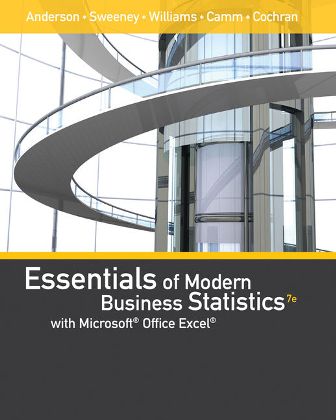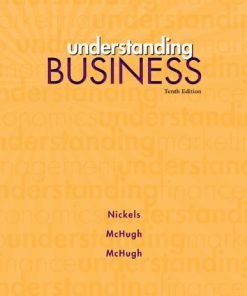Solution Manual for Essentials of Modern Business Statistics with Microsoft Excel, 7th Edition, David R. Anderson
$35.00 Original price was: $35.00.$26.50Current price is: $26.50.
Solution Manual for Essentials of Modern Business Statistics with Microsoft Excel, 7th Edition, David R. Anderson,
Instant download Solution Manual for Essentials of Modern Business Statistics with Microsoft Excel, 7th Edition, David R. Anderson pdf docx epub after payment.

Product details:
- ISBN-10 : 1337298352
- ISBN-13 : 978-1337298353
- Author: David R. Anderson; Dennis J. Sweeney; Thomas A. Williams
Discover an accessible introduction to business statistics as ESSENTIALS OF MODERN BUSINESS STATISTICS, 7E balances a conceptual understanding of statistics with real-world applications of statistical methodology. The book integrates Microsoft Excel 2016, providing step-by-step instructions and screen captures to help you master the latest Excel tools. Extremely reader-friendly, this edition includes numerous tools to maximize your course success, including Self-Test Exercises, margin annotations, insightful Notes and Comments, and real-world Methods and Applications exercises. Eleven new Case Problems, as well as new Statistics in Practice applications and real data examples and exercises, give you opportunities to put what you learn into practice. Additional learning resources, including MindTap and CengageNOW for online homework assistance and a complete support website, provide everything to acquire Excel 2016 skills and an understanding of business statistics.
Table of contents:
- Chapter 1: Data and Statistics
- Statistics In Practice: Bloomberg Businessweek
- 1.1 Applications in Business and Economics
- Accounting
- Finance
- Marketing
- Production
- Economics
- Information Systems
- 1.2 Data
- Elements, Variables, and Observations
- Scales of Measurement
- Categorical and Quantitative Data
- Cross-Sectional and Time Series Data
- 1.3 Data Sources
- Existing Sources
- Observational Study
- Experiment
- Time and Cost Issues
- Data Acquisition Errors
- 1.4 Descriptive Statistics
- 1.5 Statistical Inference
- 1.6 Statistical Analysis Using Microsoft Excel
- Data Sets and Excel Worksheets
- Using Excel for Statistical Analysis
- 1.7 Analytics
- 1.8 Big Data and Data Mining
- 1.9 Ethical Guidelines for Statistical Practice
- Summary
- Glossary
- Supplementary Exercises
- Chapter 2: Descriptive Statistics: Tabular and Graphical Displays
- Statistics In Practice: Colgate-Palmolive Company
- 2.1 Summarizing Data for a Categorical Variable
- Frequency Distribution
- Relative Frequency and Percent Frequency Distributions
- Using Excel to Construct a Frequency Distribution, a Relative Frequency Distribution, and a Percent
- Bar Charts and Pie Charts
- Using Excel to Construct a Bar Chart and a Pie Chart
- 2.2 Summarizing Data for a Quantitative Variable
- Frequency Distribution
- Relative Frequency and Percent Frequency Distributions
- Using Excel to Construct a Frequency Distribution
- Dot Plot
- Histogram
- Using Excel’s Recommended Charts Tool to Construct a Histogram
- Cumulative Distributions
- Stem-and-Leaf Display
- 2.3 Summarizing Data for Two Variables Using Tables
- Crosstabulation
- Using Excel’s PivotTable Tool to Construct a Crosstabulation
- Simpson’s Paradox
- 2.4 Summarizing Data for Two Variables Using Graphical Displays
- Scatter Diagram and Trendline
- Using Excel to Construct a Scatter Diagram and a Trendline
- Side-by-Side and Stacked Bar Charts
- Using Excel’s Recommended Charts Tool to Construct Side-by-Side and Stacked Bar Charts
- 2.5 Data Visualization: Best Practices in Creating Effective Graphical Displays
- Creating Effective Graphical Displays
- Choosing the Type of Graphical Display
- Data Dashboards
- Data Visualization in Practice: Cincinnati Zoo and Botanical Garden
- Summary
- Glossary
- Key Formulas
- Supplementary Exercises
- Case Problem 1: Pelican Stores
- Case Problem 2: Motion Picture Industry
- Case Problem 3: Queen City
- Case Problem 4: Cut-Rate Machining, Inc.
- Chapter 3: Descriptive Statistics: Numerical Measures
- Statistics In Practice: Small Fry Design
- 3.1 Measures of Location
- Mean
- Median
- Mode
- Using Excel to Compute the Mean, Median, and Mode
- Weighted Mean
- Geometric Mean
- Using Excel to Compute the Geometric Mean
- Percentiles
- Quartiles
- Using Excel to Compute Percentiles and Quartiles
- 3.2 Measures of Variability
- Range
- Interquartile Range
- Variance
- Standard Deviation
- Using Excel to Compute the Sample Variance and Sample Standard Deviation
- Coefficient of Variation
- Using Excel’s Descriptive Statistics Tool
- 3.3 Measures of Distribution Shape, Relative Location, and Detecting Outliers
- Distribution Shape
- z-Scores
- Chebyshev’s Theorem
- Empirical Rule
- Detecting Outliers
- 3.4 Five-Number Summaries and Box Plots
- Five-Number Summary
- Box Plot
- Using Excel to Construct a Box Plot
- Comparative Analysis Using Box Plots
- Using Excel to Construct a Comparative Analysis Using Box Plots
- 3.5 Measures of Association Between Two Variables
- Covariance
- Interpretation of the Covariance
- Correlation Coefficient
- Interpretation of the Correlation Coefficient
- Using Excel to Compute the Sample Covariance and Sample Correlation Coefficient
- 3.6 Data Dashboards: Adding Numerical Measures to Improve Effectiveness
- Summary
- Glossary
- Key Formulas
- Supplementary Exercises
- Case Problem 1: Pelican Stores
- Case Problem 2: Motion Picture Industry
- Case Problem 3: Business Schools of Asia-Pacific
- Case Problem 4: Heavenly Chocolates Website Transactions
- Case Problem 5: African Elephant Populations
- Chapter 4: Introduction to Probability
- Statistics In Practice: National Aeronautics And Space Administration
- 4.1 Experiments, Counting Rules, and Assigning Probabilities
- Counting Rules, Combinations, and Permutations
- Assigning Probabilities
- Probabilities for the KP&L Project
- 4.2 Events and Their Probabilities
- 4.3 Some Basic Relationships of Probability
- Complement of an Event
- Addition Law
- 4.4 Conditional Probability
- Independent Events
- Multiplication Law
- 4.5 Bayes’ Theorem
- Tabular Approach
- Summary
- Glossary
- Key Formulas
- Supplementary Exercises
- Case Problem 1: Hamilton County Judges
- Case Problem 2: Rob’s Market
- Chapter 5: Discrete Probability Distributions
- Statistics In Practice: Citibank
- 5.1 Random Variables
- Discrete Random Variables
- Continuous Random Variables
- 5.2 Developing Discrete Probability Distributions
- 5.3 Expected Value and Variance
- Expected Value
- Variance
- Using Excel to Compute the Expected Value, Variance, and Standard Deviation
- 5.4 Bivariate Distributions, Covariance, and Financial Portfolios
- A Bivariate Empirical Discrete Probability Distribution
- Financial Applications
- Summary
- 5.5 Binomial Probability Distribution
- A Binomial Experiment
- Martin Clothing Store Problem
- Using Excel to Compute Binomial Probabilities
- Expected Value and Variance for the Binomial Distribution
- 5.6 Poisson Probability Distribution
- An Example Involving Time Intervals
- An Example Involving Length or Distance Intervals
- Using Excel to Compute Poisson Probabilities
- 5.7 Hypergeometric Probability Distribution
- Using Excel to Compute Hypergeometric Probabilities
- Summary
- Glossary
- Key Formulas
- Supplementary Exercises
- Case Problem 1: Go Bananas!
- Case Problem 2: McNeil’s Auto Mall
- Case Problem 3: Grievance Committee at Tuglar Corporation
- Case Problem 4: Sagittarius Casino
People also search:
Essentials of Modern Business Statistics with Microsoft Excel, 7th Edition
Essentials of Modern Business Statistics with Microsoft Excel, 7th Edition pdf
Essentials of Modern Business Statistics with Microsoft Excel
|
essentials of modern business statistics with microsoft office excel
|
|
essentials of modern business statistics with microsoft excel solution
|
Related products
Solution Manual
Management Information Systems Managing the Digital Firm Laudon 14th Edition Solutions Manual
Solution Manual
Understanding Business Nickels 10th Edition Solutions Manual
Solution Manual
Solution Manual for Data Structures and Other Objects Using C++, 4/E Michael Main, Walter Savitch
Solution Manual
Solution manual for Accounting: Tools for Business Decision Making Kimmel Weygandt Kieso 5th Edition
Solution Manual
Solution Manual for Introduction to Robotics Mechanics and Control 3rd Edition by Craig











